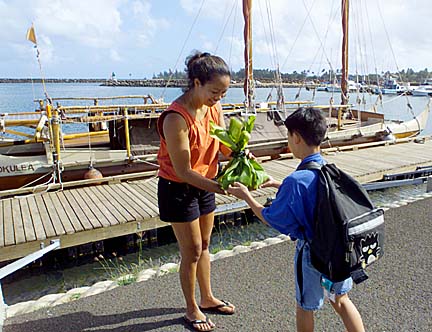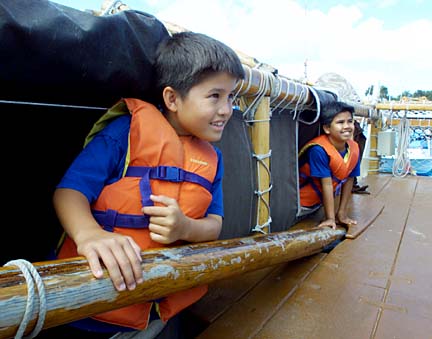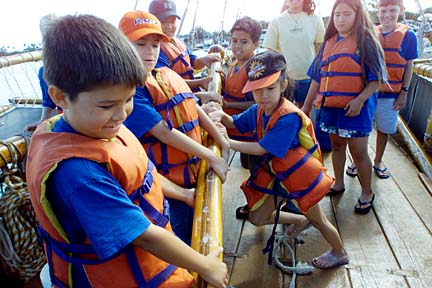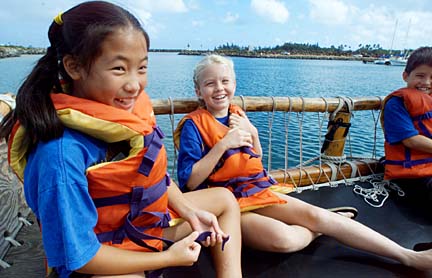


There IT was, on a quiet Wednesday morning last week, more than just another boat amongst the many docked in Haleiwa Boat Harbor. After all, its the pride of the state, the pride of Polynesia.
A group of Mililani students
Where to see it By Gary C.W. Chun
visits the famous Hokule‘a
and learns about malama
Star-BulletinEven though it's been a little more than 25 years since its first historic voyage to and from Tahiti, the Hokule'a, the "star of gladness," still has an aura about it.
The double-hulled canoe and its handlers from the Polynesian Voyaging Society are wrapping up a second statewide tour here on Oahu (the first one being in 1996-'97), celebrating a quarter of a century of Hokule'a's achievements.

The theme of the tour is Malama Hawai'i -- caring for our special island home. And it's a creed that has been spread to those who have visited the Hokule'a since late September, when the tour began in Kauai, then headed to the Big Island, Lanai, Maui, Molokai and, finally, Oahu.During the morning hours last Wednesday, the Hokule'a was the focal point of a two-hour outdoor classroom for elementary school kids who occasionally were distracted by one of the harbor's fisherfolk who was fishing nearby.
The first group of students was made up of fourth-graders, the Mililani-Mauka Elementary Golden Eagles, all proudly dressed in the school's blue logo T-shirts, the latest of thousands of kids who have taken this special anniversary tour.
As supervising teachers were busily taking photos of the kids, Vickie Shiroma, one of the teachers, said that even though public schools were being discouraged to take field trips because of lost classroom time due to the teachers' strike, they decided "this is a once in a lifetime opportunity."

Unfortunately, the kids had been expecting to get maybe a little wet; weighed down by their collective backpacks, everyone had dressed to go out to sea. Several grandparents also had come along, ready to watch their grandkids go sailing away. But the Hokule'a's sails remained lashed to her two masts. Because of the solidly booked tour schedule and large school groups, there just wasn't enough time for the canoe to leave her berth.But the Mililani-Mauka group made the most of it, huddling together to do a welcoming chant and then offering a makana (gift) of traditional ti-leaf wrapped ho'okupu to the society's site coordinator Shantell Ching and her co-educators, Kaiulani Murphy, Kaliko Amona and David Bush, all of whom have sailed on the Hokule'a on its journeys through Polynesia.
Ching said she was delighted with the kids' presentation, as they were the first group ever to do that on a tour stop. Under a light rain, she said she and the others were eager to "share the canoe with you." (Ching, who formulated the school tour activities, said that, in particular, "we want to target the fourth graders, because Hawaiian studies is part of their curriculum.")

The kids were divided into four groups, as they would rotate between four activity stations, inlcuding one on board the double-hulled canoe. Before boarding, the kids had to shed their bulky backpacks, put on lifejackets and become "make-believe crew members.""Hmmm -- this feels comfortable -- I could get used to this!" said Hideki Aoki, his green UH sports cap protecting his head from the mid-morning sun. He bounced a bit on the trampoline platforms that flank the aft sides of the canoe.
Kaiulani Murphy told the small group on board that the canoe is the crew's home for a month, complete with a toilet, two burners for a kitchen, and beds, but no refrigerator.
"We don't have the luxury of ice cream," she said, but they do take plastic containers with healthy food for the trip.
The most important questions the kids had on their minds were: 1) Did you ever fall? (Murphy said no, but she went over the rescue procedures that the canoe and escort boat crewmembers were prepared to follow if "man overboard" yell went up.)
And 2) How do you go to the bathroom? (The answer: As discreetly as possible, hanging off the port-side aft of the canoe, secured by a strap harness).

Bathing is usually done using a special liquid soap that lathers with salt water, but, Murphy added, "We like it when it rains, because we can then take a fresh water shower when a squall hits us."The kids eagerly volunteered to handle the large steering paddle or operate the bilge pump, when they weren't scurrying into the sleeping quarters that flanked both sides of the canoe, a combination of bunk and storage space.
Personal hygiene concerns aside, the kids seemed well-prepared for their field trip, rattling off what a navigator uses to steer the canoe and what kind of crewmembers are needed for a safe voyage. But Murphy, as well as the rest of the educators, emphasized throughout the tour the importance of malama as well.
"To value the importance of malama on the canoe, to care both for your crewmembers and for yourself" said the large display poster Kaliko Amona held up to her group sitting under an onshore tent. "Malama your environment, applied to the seaworthiness of the canoe and to bring it home safely."
The kids understood that they had to "malama our family, friends, malama the ocean" and have "aloha for yourself and each other."
"Hawaii, our island home, is our canoe, Malama Hawaii" went another poster statement, as Amona followed up her presentation with a discussion of the state's indigenous plant and animal species.
Next to Amona's group was David Bush's activity group, learning about what kinds of provisions are needed for the Hokule'a 's long journeys.
"Do you bring your Playstation or toilet paper?," he asked.

Well, that was pretty easy to answer, but as his group divvied up into smaller groups, each with their own set of laminated picture cards, the volume of chatter rose as they chose what things they would take with them on their voyage.Short, loud declarations of "Yes!" "No!" "We need that!" were overheard. "Do we need razor blades?" a clean-faced Brandon Enos queried.
When choices were later evaluated, Bush said, a comb should've been part of a "yes" pile, but thankfully, no one thought it was appropriate to take a skateboard with them.
Shantell Ching worked with a large blue tarp segmented by different-colored string to provide a makeshift navigation grid, as she told her group about the Hokule'a's travels within the Polynesian triangle, made up of Rapa Nui (Easter Island), the Hawaiian Islands and New Zealand.
Before bringing the canoe home for its 25th anniversary, Hokule'a's last major voyage was to Rapa Nui, between June 1999 through March 2000.
Ching said "getting to Rapa Nui was our biggest challenge, because it's located in the far southeastern corner of the Polynesian triangle, an island smaller than Kahoolawe and isolated in the midst of 1,400 miles of ocean all around it."
The Society's three top navigators, Nainoa Thompson, Bruce Blankenfeld and Chad Baybayan, in their year's worth of preparation for the voyage, thought the only way the Hokule'a could get there was through tacking at angles against the wind.
Ching said she and the crew wore four layers of clothing because of the cold caused by the voyage's southward direction from their port in Mangareva. And what was originally thought would be a 42-day voyage only became 18 as they were blessed with winds that pushed them from behind.
Learning navigation became a game, as Ching had the kids try to guess a preconceived route she had in mind. As each child successively stepped into a grid square and said what direction he or she was going, Ching would playfully say either "beep" for a right move or "buzz" for a wrong one, until one of the kids successfully reached her on the other side of the tarp.
While Ching understood the kids' initial disappointment at not being able to leave the dock, she said that, in order to sail, "we need six to eight experienced sailors, and an escort boat, but with the logistics of coordinating our work schedules, it's difficult finding people to take kids and community members out," although community members have been able to sail with the Hokule'a when it leaves one port for another on the same island.
"People have been so helpful, so hospitable," Ching said of the statewide tour. "They welcome us with open arms, bring food to the crew, help us set up the tents and even volunteer to do overnight anchor watches."
Ching said there are talks about future Hokule'a voyages, with routes to the Northwest Hawaiian Islands beyond Niihau and Japan being discussed.
"We wanted to disprove 'scientific' theories that Polynesians didn't know how to sail longer distances, besides interisland, or had the navigational skills to do it," said Ching.
Because of the canoe's success, there now are more double-hulled voyaging canoes throughout Polynesia.
Ching herself was inspired to sail when, in 1976, the canoe's crew members came to her Kapalama Elementary classroom to give a presentation. In 1993, she met Nainoa Thompson and hasn't looked back since. Now a navigator, Ching said she took the canoe from Tahiti back to Hawaii last year.
"I didn't feel lost at all," she said confidentally, adding a chuckle, "but once you sail, the more you like sail!"
Hokule'a will be docked at Waianae Boat Harbor until Saturday morning. The canoe will sail that day to Ko Olina Marina, where it will be docked until May 19. It then will return to its usual berth at the Hawai'i Maritime Center at Pier 7 in Honolulu Harbor. For more information, call the Polynesian Voyaging Society at 536-8405.
Click for online
calendars and events.